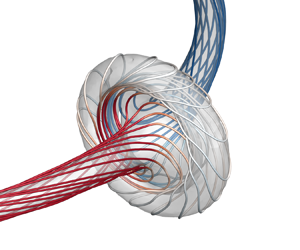Published online by Cambridge University Press: 04 September 2023

Helicity, an invariant under ideal-fluid (Euler) evolution, has a topological interpretation in terms of writhe and twist for a closed vortex tube, but accurately quantifying twist is challenging in viscous flows. With a novel helicity decomposition, we present a framework to construct the differential twist that establishes the theoretical relation between the total twisting number and the local twist rate of each vortex surface. This framework can characterize coiling vortex lines and internal structures within a vortex – important in laminar–turbulence transition, and in vortex instability, reconnection and breakdown. As a typical example, we explore the dynamics of vortex rings with differential twist via direct numerical simulation (DNS) of the Navier–Stokes equations. Two twist waves with opposite chiralities propagate towards each other along the ring and then collide whence the local twist rate rapidly surges. Local vortex surfaces are squeezed into a disk-like dipole structure containing coiled vortex lines, leading to vortex bursting. We derive a Burgers-equation-like model to quantify this process, which predicts a bursting time that agrees well with DNS.